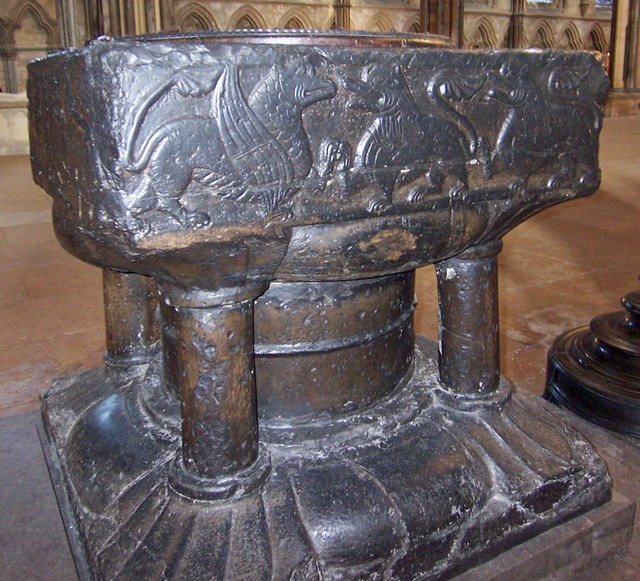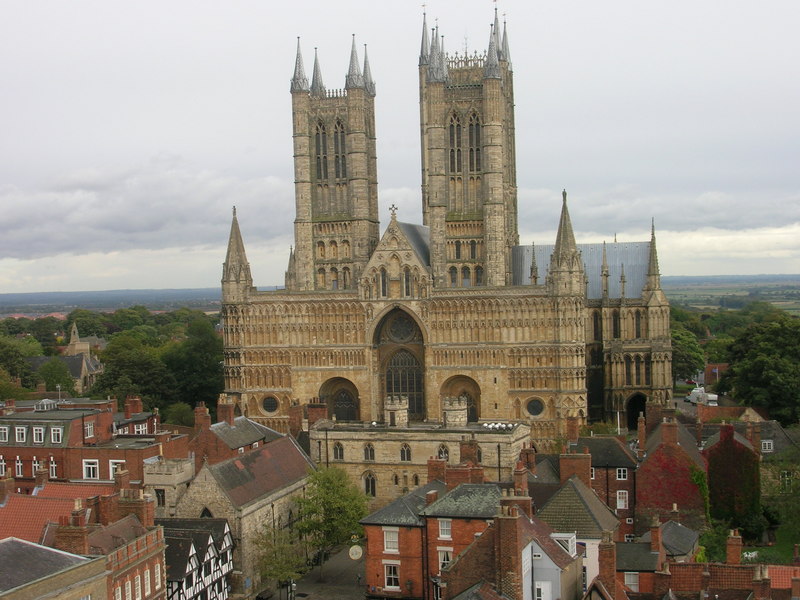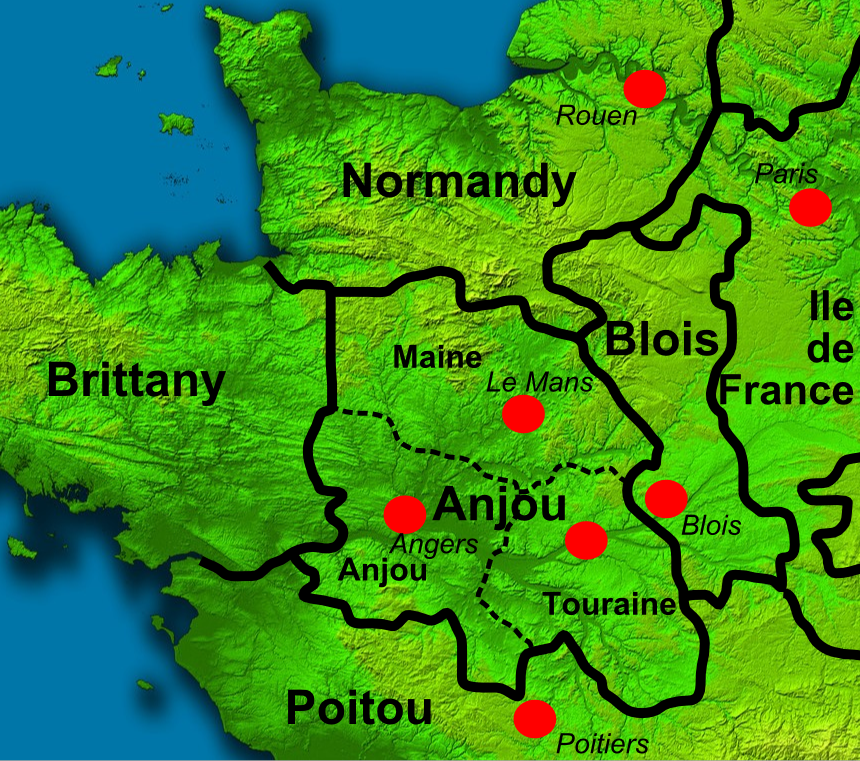|
Robert De Chesney
Robert de Chesney (died December 1166) was a medieval English Bishop of Lincoln. He was the brother of an important royal official, William de Chesney, and the uncle of Gilbert Foliot, successively Bishop of Hereford and Bishop of London. Educated at Oxford or Paris, Chesney was Archdeacon of Leicester before his election as bishop in December 1148. Chesney served as a royal justice in Lincolnshire during his bishopric, and maintained a close relationship with his nephew, Foliot. He was also an early patron of Thomas Becket, and gave the young cleric an office in his diocese early in Becket's career. Although shown favour by Stephen of England, King Stephen, including the right to a Mint (facility), mint, Chesney was present at the coronation of Henry II of England, King Henry II in 1154 and went on to serve Henry as a royal justice. Around 1160, Chesney became embroiled in a dispute with St Albans Abbey in the diocese of Lincoln, over his right as bishop to supervise the abbey. T ... [...More Info...] [...Related Items...] OR: [Wikipedia] [Google] [Baidu] |
Diocese Of Lincoln
The Diocese of Lincoln forms part of the Province of Canterbury in England. The present diocese covers the ceremonial county of Lincolnshire. History The diocese traces its roots in an unbroken line to the Pre-Reformation Diocese of Leicester, founded in 679. The see of Leicester was translated to Dorchester in the late 9th century, before taking in the territory of the Diocese of Lindsey and being translated to Lincoln. The diocese was then the largest in England, extending from the River Thames to the Humber Estuary. In 1072, Remigius de Fécamp, bishop under William the Conqueror, moved the see to Lincoln, although the Bishops of Lincoln retained significant landholdings within Oxfordshire. Because of this historic link, for a long time Banbury remained a peculiar of the Bishop of Lincoln. The modern diocese remains notoriously extensive, having been reportedly referred to by Bob Hardy, Bishop of Lincoln, as "2,000 square miles of bugger all" in 2002. The dioces ... [...More Info...] [...Related Items...] OR: [Wikipedia] [Google] [Baidu] |
Lincoln Cathedral
Lincoln Cathedral, also called Lincoln Minster, and formally the Cathedral Church of the Blessed Virgin Mary of Lincoln, is a Church of England cathedral in Lincoln, England, Lincoln, England. It is the seat of the bishop of Lincoln and is the Mother Church#Cathedral, mother church of the diocese of Lincoln. The cathedral is governed by its Dean of Lincoln, dean and Chapter (religion), chapter, and is a Listed building, grade I listed building. The earliest parts of the current building date to 1072, when bishop Remigius de Fécamp moved his seat from Dorchester on Thames to Lincoln. The building was completed in 1092, but severely damaged in 1185 East Midlands earthquake, an earthquake in 1185. It was rebuilt over the following centuries in different phases of the English Gothic architecture, Gothic style, with significant surviving parts of the cathedral in English Gothic architecture#Early English Gothic, Early English, Decorated Gothic, Decorated and Perpendicular architecture ... [...More Info...] [...Related Items...] OR: [Wikipedia] [Google] [Baidu] |
Roger Of Salisbury
Roger of Salisbury (died 1139), was a Norman medieval bishop of Salisbury and the seventh Lord Chancellor and Lord Keeper of England. Life Roger was originally priest of a small chapel near Caen in Normandy. He was called "Roger, priest of the church of Avranches", in his notification of election to the bishopric. The future King Henry I, who happened to hear mass there one day, was impressed by the speed with which Roger read the service and enrolled him in his own service. According to William of Newburgh, Roger was poor and uneducated, but this is considered unlikely by the historian B. R. Kemp. On coming to the throne, Henry almost immediately made him Chancellor in 1101. He held that office until late 1102. On 29 September 1102 Roger received the bishopric of Salisbury at Old Sarum Cathedral, but he was not consecrated until 11 August 1107 owing to the dispute between Henry and him. He was consecrated at Canterbury. During the dispute between Henry and Archbishop Ans ... [...More Info...] [...Related Items...] OR: [Wikipedia] [Google] [Baidu] |
Robert, 1st Earl Of Gloucester
Robert FitzRoy, 1st Earl of Gloucester (c. 1090 – 31 October 1147 David Crouch, 'Robert, first earl of Gloucester (b. c. 1090, d. 1147)', Oxford Dictionary of National Biography, Oxford University Press, 2004; online edn, May 200Retrieved 1 October 2010/ref>) (''alias'' Robert Rufus, Robert de Caen ( Latinised to Robertus de Cadomo), Robert Consul) was an illegitimate son of King Henry I of England. He was the half-brother of the Empress Matilda, and her chief military supporter during the civil war known as the Anarchy, in which she vied with Stephen of Blois for the throne of England. Early life Robert was probably the eldest of Henry's many illegitimate children. He was born before his father's accession to the English throne, either during the reign of his grandfather William the Conqueror or his uncle William Rufus. He is sometimes and erroneously designated as a son of Nest, daughter of Rhys ap Tewdwr, last king of Deheubarth, although his mother has been id ... [...More Info...] [...Related Items...] OR: [Wikipedia] [Google] [Baidu] |
David I Of Scotland
David I or Dauíd mac Maíl Choluim (Scottish Gaelic, Modern Gaelic: ''Daibhidh I mac [Mhaoil] Chaluim''; – 24 May 1153) was a 12th century ruler and saint who was David I as Prince of the Cumbrians, Prince of the Cumbrians from 1113 to 1124 and King of Scotland from 1124 to 1153. The youngest son of King Malcolm III and Saint Margaret of Scotland, Queen Margaret, David spent most of his childhood in Scotland but was exiled to Kingdom of England, England temporarily in 1093. Perhaps after 1100, he became a dependent at the court of King Henry I of England, by whom he was influenced. When David's brother Alexander I of Scotland, Alexander I died in 1124, David chose, with the backing of Henry I, to take the Kingdom of Alba (Scotland) for himself. He was forced to engage in warfare against his rival and nephew, Máel Coluim mac Alaxandair. Subduing the latter seems to have taken David ten years, a struggle that involved the destruction of Óengus of Moray, Óengus, Mormaer of ... [...More Info...] [...Related Items...] OR: [Wikipedia] [Google] [Baidu] |
Fealty
An oath of fealty, from the Latin (faithfulness), is a pledge of allegiance of one person to another. Definition In medieval Europe, the swearing of fealty took the form of an oath made by a vassal, or subordinate, to his lord. "Fealty" also referred to the duties incumbent upon a vassal that were owed to the lord, which consisted of service and aid.Coredon, ''A Dictionary of Medieval Terms and Phrases'', p. 120 One part of the oath of fealty included swearing to always remain faithful to the lord. The oath of fealty usually took place after the act of homage (medieval), homage, when, by the symbolic act of kneeling before the lord and placing his hands between the hands of the lord, the vassal became the "man" of the lord. Usually, the lord also promised to provide for the vassal in some form, either through the granting of a fief or by some other manner of support.Saul, "Feudalism", ''Companion to Medieval England'', pp. 102–105 Typically, the oath took place upon a religio ... [...More Info...] [...Related Items...] OR: [Wikipedia] [Google] [Baidu] |
Normandy
Normandy (; or ) is a geographical and cultural region in northwestern Europe, roughly coextensive with the historical Duchy of Normandy. Normandy comprises Normandy (administrative region), mainland Normandy (a part of France) and insular Normandy (mostly the British Channel Islands). It covers . Its population in 2017 was 3,499,280. The inhabitants of Normandy are known as Normans; the region is the historic homeland of the Norman language. Large settlements include Rouen, Caen, Le Havre and Cherbourg-en-Cotentin, Cherbourg. The cultural region of Normandy is roughly similar to the historical Duchy of Normandy, which includes small areas now part of the departments of Mayenne and Sarthe. The Channel Islands (French: ''Îles Anglo-Normandes'') are also historically part of Normandy; they cover and comprise two bailiwicks: Bailiwick of Guernsey, Guernsey and Jersey, which are British Crown Dependencies. Normandy's name comes from the settlement of the territory by Vikings ( ... [...More Info...] [...Related Items...] OR: [Wikipedia] [Google] [Baidu] |
Geoffrey Plantagenet, Count Of Anjou
Geoffrey V (24 August 1113 – 7 September 1151), called the Fair (), Plantagenet, and of Anjou, was the count of Anjou and Maine by inheritance from 1129, and also duke of Normandy by his marriage claim and conquest, from 1144. Geoffrey married Empress Matilda, daughter of Henry I, king of England and duke of Normandy. Geoffrey and Matilda's marriage led, through their son Henry II, to the 300-year long reign of the Plantagenet dynasty in England. Although it was never his family name or last name, "Plantagenet" was taken for the dynasty from Geoffrey's epithet, long after his death. Geoffrey's ancestral domain of Anjou in north central France gives rise to the name Angevin, and what modern historians name as the Angevin Empire in the 12th century. Early life Geoffrey was the elder son of Fulk V of Anjou and Ermengarde of Maine. The chronicler John of Marmoutier described Geoffrey as handsome, red haired, jovial, and a great warrior. King Henry I of Engla ... [...More Info...] [...Related Items...] OR: [Wikipedia] [Google] [Baidu] |
Theobald II, Count Of Champagne
Theobald the Great (1090–1152) was count of Blois and of Chartres as Theobald IV from 1102 and was Count of Champagne and of Brie as Theobald II from 1125. Theobald held Auxerre, Maligny, Ervy, Troyes and Châteauvillain as fiefs from Odo II, Duke of Burgundy. Career Theobald was the son of Count Stephen II of Blois and his wife Adela of Normandy (daughter of William the Conqueror), and the elder brother of King Stephen of England. Although he was the second son, Theobald was appointed above his older brother William. Theobald accompanied his mother throughout their domain on hundreds of occasions and, after her retirement to Marcigney in 1125, he administered the family properties with great skill. Adela died in her beloved convent on 8 March 1137, the year after her son Stephen was crowned king of England. King Louis VII of France became involved in a war with Theobald by permitting Count Raoul I of Vermandois, seneschal of France, to repudiate his wife Eleanor, s ... [...More Info...] [...Related Items...] OR: [Wikipedia] [Google] [Baidu] |
Stephen, King Of England
Stephen (1092 or 1096 – 25 October 1154), often referred to as Stephen of Blois, was King of England from 22 December 1135 to his death in 1154. He was Count of Boulogne ''jure uxoris'' from 1125 until 1147 and Duke of Normandy from 1135 until 1144. His reign was marked by the Anarchy, a civil war with his cousin and rival, the Empress Matilda, whose son, Henry II, succeeded Stephen as the first of the Angevin kings of England. Stephen was born in the County of Blois in central France as the fourth son of Stephen-Henry, Count of Blois, and Adela, daughter of William the Conqueror. His father died as a crusader while Stephen was still young, and he was brought up by his mother. Placed into the court of his uncle Henry I of England, Stephen rose in prominence and was granted extensive lands. He married Matilda of Boulogne, inheriting additional estates in Kent and Boulogne that made the couple one of the wealthiest in England. Stephen narrowly escaped drowning with ... [...More Info...] [...Related Items...] OR: [Wikipedia] [Google] [Baidu] |
Holy Roman Empire
The Holy Roman Empire, also known as the Holy Roman Empire of the German Nation after 1512, was a polity in Central and Western Europe, usually headed by the Holy Roman Emperor. It developed in the Early Middle Ages, and lasted for a millennium until its Dissolution of the Holy Roman Empire, dissolution in 1806 during the Napoleonic Wars. For most of its history the Empire comprised the entirety of the modern countries of Germany, Czechia, Austria, the Netherlands, Belgium, Switzerland, Slovenia, and Luxembourg, most of north-central Italy, and large parts of modern-day east France and west Poland. On 25 December 800, Pope Leo III crowned the Frankish king Charlemagne Roman emperor, reviving the title more than three centuries after the fall of the Western Roman Empire in 476. The title lapsed in 924, but was revived in 962 when Otto I, OttoI was crowned emperor by Pope John XII, as Charlemagne's and the Carolingian Empire's successor. From 962 until the 12th century, the empire ... [...More Info...] [...Related Items...] OR: [Wikipedia] [Google] [Baidu] |
Empress Matilda
Empress Matilda (10 September 1167), also known as Empress Maud, was one of the claimants to the English throne during the civil war known as the Anarchy. The daughter and heir of Henry I, king of England and ruler of Normandy, she went to Germany as a child when she was married to the future Holy Roman Emperor Henry V. She travelled with the emperor to Italy in 1116, was controversially crowned empress in St Peter's Basilica, and acted as the imperial regent in Italy. Matilda and Henry V had no children, and when he died in 1125, the imperial crown was claimed by his rival Lothair of Supplinburg. Matilda's younger and only full brother, William Adelin, died in the ''White Ship'' disaster of 1120, leaving Matilda's father and realm facing a potential succession crisis. Upon her widowhood in the Holy Roman Empire, Matilda was recalled to Normandy by her father, who arranged for her to marry Geoffrey of Anjou to form an alliance to protect his southern borders in Franc ... [...More Info...] [...Related Items...] OR: [Wikipedia] [Google] [Baidu] |









